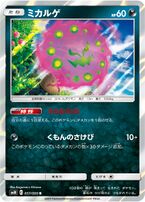From Bulbapedia, the community-driven Pokémon encyclopedia.
Spiritomb was a Pokémon Trading Card Game deck archetype played between the 2018-19 to the 2020-21 season. The deck's strategy revolved around damaging the player's own Spiritomb to increase its damage output. Spiritomb players have been featured at Top 16 in Players Cup III and Top 8 in Players Cup IV, as well other relevant spots at Regional events.
Strategy
Spiritomb could, for one Energy, attack for 10 damage plus 30 for each damage counter on itself. This was easily done thanks to its unusual Ability that allowed adding a damage counter to itself during the player's turn. This deck was notable for the possible damage of a Pokémon that only gave the opponent one Prize card when knocked out.
The deck featured secondary attackers that mainly only needed one Energy card to attack to deal with opposing Pokémon while damage counters were built up until the release of Spikemuth, which allowed speeding up the placement of damage counters through retreating and switching cards to activate its effect and to Spiritomb to be the main or only attacker. Even if the player's Spiritomb would get constantly be defeated, which could be the case as it only had 60HP, another being built up damage from the Bench could come out and quickly attack. Jirachi was also played to get more Trainer cards from the deck.
Key cards
- Spiritomb - Anguish Cry dealt 10 damage plus 30 to each damage counter on itself, and the Building Spite Ability let the player place one damage counter on it during their turn. This meant up to 160 damage with 5 damage counters, or up to 310 damage with Cape of Toughness though it took more turns and no opponent interference to deal as much damage. Notably had no Weaknesses, even if its low HP meant it would be constantly knocked out.
- Jirachi - Once per turn when in the Active spot, Jirachi's Ability let the player look at the top 5 cards and put a Trainer card from there to their hand. Jirachi then becomes Asleep, but this is mitigated by the switching cards the deck played.
- Jynx - Once per turn, moved one damage counter between the player's Pokémon. This could power up a Spiritomb quicker and/or move away damage from a Pokémon that would be knocked out by the opponent or Spikemuth's damage.
- Mew - Prevented damage to Benched Pokémon. Would not stop some effects such as Inteleon's damage counter placement, which required instead for the player to not have too much damaged Pokémon.
- Nest Ball - While in the format, put a Basic Pokémon from the player's deck to their Bench. Quick Ball and Level Ball were released later which also helped getting most Pokémon from the archetype.
- Scoop Up Net - Put a Basic non-GX Pokémon to the player's hand, allowing Jirachi and Jynx's Ability to be reused as well moving Spiritomb to the Active spot if needed.
- Spikemuth - While in play, added two damage counters to Pokémon that moved to the Bench during its player's turn. This was benefical to the player as they wanted to quickly build damage on their own Spiritomb, so the player would constantly play switching cards or retreat their Pokémon. As Spiritomb only has 60HP without other effects and could already place damage counters on itself, in many situations it was better to "spread" the damage done to Spiritomb rather than building damage in a single one during the player's turn.
- Rainbow Energy - While legal in the format, it counted as an Energy of any type but put a damage counter on the Pokémon it was attached to. This was both benefical to Spiritomb's damage and the possibility of using attackers of other types.
- Hiding D Energy - Released along with Spikemuth, removed the retreat cost of
 Pokémon this Energy was attached to.
Pokémon this Energy was attached to.
Typical decklist
Hunter Butler's decklist at the 2019 North America Internationals
|
Bruno Sermann's decklist at Players Cup IV
|
Possible tech cards
The following cards are often used in Spiritomb in place of certain cards included in the above lists.
- Stunfisk - Dealt 30 damage times the number of the player's Benched Pokémon with damage counters. Useful as Spiritomb could damage itself, but required Double Colorless Energy to attack with a single Energy card.
- Honchkrow-GX - Stage 1 Pokémon that prevented the opponent from attaching Stadium, Special Energy and Pokémon Tool cards from their hand, though this effect only worked as long it was in the Active spot and it had a
 Weakness plus an average attack.
Weakness plus an average attack.
- Oricorio-GX - Its Ability allowed the to player draw cards whenever a Pokémon was knocked out.
 Pokémon this Energy was attached to.
Pokémon this Energy was attached to. Weakness plus an average attack.
Weakness plus an average attack.



